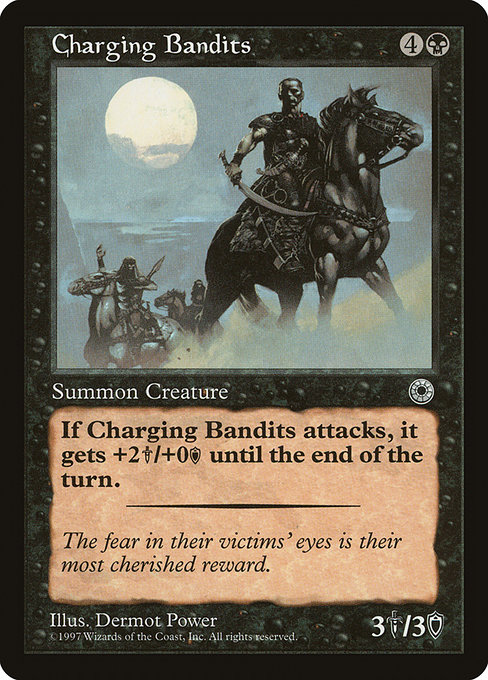
Image courtesy of Scryfall.com
Guarding the Night: Tactical Layers for a Black Rogue on the Offensive
Charging Bandits is a throughline of classic Mystery Box MTG vibes: a lean, aggressive creature that wants to swing and push a little extra power onto the board as soon as combat starts. This Portal-era common sense of tempo and risk gives players a taste of what black's rogues can do when they lean into pressure. For a mana cost of 4 generic and 1 black, you’re getting a 3/3 with a very juicy extra—Whenever this creature attacks, it gets +2/+0 until end of turn. That means on the moment you declare attacks, it can suddenly resemble a 5/3, often forcing a decision on blockers or trading that keeps your opponent reeling. The flavor text—“The fear in their victims' eyes is their most cherished reward.”—hums with a gritty, early-Magic vibe 🧙♂️🔥💎. Dermot Power’s art catches the light and the menace in one sharp stroke, a reminder that in older sets, rogues didn’t just sneak by—you earned the moment they flinched.
Today we’re unpacking this card through two lenses: protection and evasion. In a format where Legacy and Vintage remain the playgrounds for older black strategies, Charging Bandits shines brightest when you think about how to keep it alive, and how to bend combat so its trigger hits consistently. It’s a creature that rewards smart combat math and careful timing, not brute force alone 🧙♂️⚔️.
Card Snapshot at a Glance
- Name: Charging Bandits
- Mana Cost: 4B
- Converted Mana Cost (CMC): 5
- Type: Creature — Human Rogue
- Power/Toughness: 3/3
- Set: Portal (por), 1997
- Rarity: Uncommon
- Oracle Text: Whenever this creature attacks, it gets +2/+0 until end of turn.
- Flavor Text: The fear in their victims' eyes is their most cherished reward.
Protection: Keeping the Bandits in the Fight
Protection strategies aren’t about turning your rogue into an indestructible wall; it’s about making sure your tempo isn’t cratered by one well-timed removal spell. In black-dominant play, you can conceptually pursue a few practical routes to protect a Bandits-driven tempo plan:
- Layered defense: Use the usual suspects of tempo and creature-based protection—either through bodies absorbing removal or through spell tricks that let your Bandits survive trades long enough to trigger again later in combat.
- Protection from troublesome colors: While not all sets grant easy access to color-based protection, there are strategies and enchantments that conceptually shield a rogue from specific removal lines. The key idea is to reduce the chance an opponent can answer the Bandits immediately, preserving your attack momentum.
- Blocker management: With a 3/3 body, you want to force favorable blocks or force trades that still leave you with a bigger post-attack threat. If you can peel away an opposing blocker or two, the Bandits’ +2/+0 buff on that first swing often carries the turn.
Evasion: Making the Attack Count
Evasion here is less about flight or shroud on the Bandits itself and more about how you guide the combat math. The trick is to maximize the impact of the +2/+0 boost and to chain pressure across turns. Practical considerations:
- Attacking as a tempo prompt: When you swing, you’re not just swinging a 3/3; you’re announcing a threat that gets more lethal within that same combat step. If your opponent blocks suboptimally, you may walk away with a bigger creature or, at minimum, push through a chunk of damage that pulls ahead on the life totals.
- Combat tricks and pump: Any spell or effect that temporarily boosts power can amplify the Bandits’ reach. Since the buff is temporary and tied to the attack step, you’ll want to time these buffs to land right after you declare attackers.
- Volatile tempo vs. board wipes: Portal-era design loves the idea that a single attack can swing a game, but it also means tempo can slip away quickly if you don’t keep pressure. Be ready to pivot toward a longer-game plan if the board becomes crowded with removal or blockers.
“A roguish smile and a counterattack that feels like a throwback to the old-school days of MTG—the moment you commit to attack, you’re writing the next line of the story.”
From a rules perspective, the Bandits’ effect is straightforward: a triggered, temporary power boost tied to attacking. It rewards decisive moves in combat and punishes indecision—perfect for players who enjoy turning a cautious opening into a rapid finish. In a Commander or casual Legacy game, you can lean on the card’s era-appropriate feel and rely on black’s other tools to fetch, discard, or reassemble threats as needed. The card’s uncommon status and Portal’s Starter-set vibe also lend a nostalgic sheen to any deck that loves “old school” combat calculus 🧙♂️🎨.
Value-wise, you’re looking at a card that sits modestly in today’s market—roughly a few dimes on the USD side and a touch more in EUR terms, depending on condition. It’s not a cornerstone stellar card, but it has a place in a thoughtful black rogue shell that appreciates the glory days of Portal and the raw, unfiltered intensity of early combat tricks. If you’re crafting a deck that wants to celebrate the old-school rogues and their rapid-fire tempo, Charging Bandits is a distinctive piece to lean on ⚔️💎.
As you plan your next session, imagine the table in a dimly lit kitchen, the cards spread out like a map of schemes, and the Bandits stepping into the glow of the lamp—ready to swing and, with a little luck, swing hard. And if you’re looking to keep your desk world equally stylish as your MTG play, a high-quality surface to track the board can be as satisfying as landing that +2 boost on turn three. Check out the neat Custom Mouse Pad 9.3 x 7.8 Non-Slip Desk Mat for that perfect desk-to-table transition, because a gamer’s workstation deserves a little magic too 🧙♂️🎲.